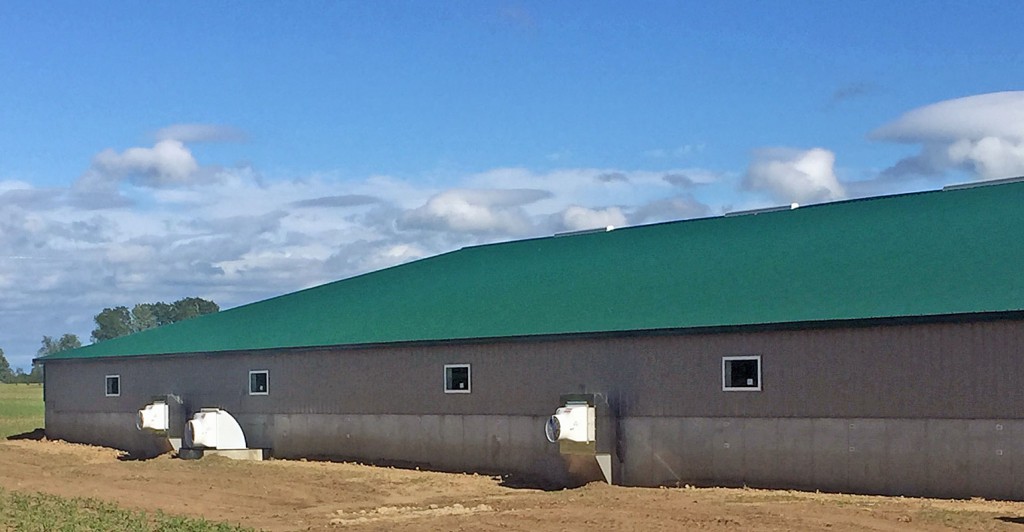 The biggest benefit of solid sided finishing facilities may be the hardest to measure.
The biggest benefit of solid sided finishing facilities may be the hardest to measure.
Recently we published an article highlighting some key factors contributing to the growing popularity of solid sided curtain finishing houses. These included heat savings, reduced maintenance, and improved ventilation.
While the heat savings and reduced maintenance cost might be the easiest to track, the most significant benefit may come from improving the pig’s environment.
The tendency when hearing heaters running continuously on a cold winter morning (especially after paying the latest LP bill) is to start easing the variable speed down or lowering the "on" cycle time for the minimum winter fans. Simple logic; cut the minimum winter rate by half from 2 cfm/pig to 1 cfm, and reduce LP usage by half.
Unfortunately, this also increases the building's relative humidity along with higher gas and dust levels. The poorer environment can cause slow growth and increase the pigs’ susceptibility to disease. In some cases, this decreased lung function will hurt performance throughout the pig's production cycle. Lower ventilation rates can also jeopardize worker's health and cause the building's interior to deteriorate quicker.
Solid sided finishing buildings, with insulated sidewalls replacing curtains, do not reduce the amount of minimum ventilation required to provide a good environment. Instead, the higher R-value walls significantly reduce the amount of heat loss compared to a curtain. The BTUs normally generated to replace heat loss through the curtains can instead be exhausted through the fans to improve the building's interior climate and pig performance.
To illustrate the amount of BTU lost through a curtain sided finisher compared to a solid sided building we calculated the heat loss for a typical sized single wide finishing unit.
Size: 1100 head Dem:
41’ x 224’
Inside Temp: 70
Outside Temp: 30
Pig Size: 12 lbs.
Ceiling: R-30
5’ Curtain: R-1
3’ x6” Concrete Wall: R-5
5’ x6” Insulated Wall: R-19
Minimum ventilation rate: 2 cfm/head
Ventilation Heat Loss
1100 head x 2 cfm/head= 2,000 cfm
2,000 x 60 = 120,000 cf/hr
120,000 x (70-30) x.018 = 86,400 BTU/Hr
Curtain Sided
Ceiling 41 x 224 = 9,184 sq. ft.
9184 x (70-30) / R-30 = 12,245 BTU/Hr
End Walls 41x 8 x 2 = 656 sq. ft.
656 x (70-30) / R-19 = 1,381 BTU/Hr
Concrete side wall 2’ x 224 x 2 = 896
896 x (70-30) / 5 = 7,168 BTU/Hr
Curtain 5’ x 224’ x 2 = 2240
2240 x (70-30) / 1 = = 89,600/ BTU/Hr
Solid Sided
Ceiling 41 x 224 = 9,184 sq. ft.
9184 x (70-30) / R-30 = 12,245 BTU/Hr
End Walls 41x 8 x 2 = 656 sq. ft.
656 x (70-30) / R-19 = 1,381 BTU/Hr
Concrete side wall 2’ x 224 x 2 = 896
896 x (70-30) / 5 = 7,168 BTU/Hr
Insulated Side wall 5’ x 224’ x 2 = 2240
2240 x (70-30) / 19 = = 4,715/ BTU/Hr
When we compare the curtain heat loss (89,600 BTU/ Hr) to the heat loss through the solid wall building (4,715 BTU/Hr.) the difference is close to 85,000 BTU/ Hr.
The 85,000 BTU lost through curtain comes very close to equaling the amount of BTU exhausted through the ventilation system. To think of it another way, it’s like doubling the ventilation fans and not getting the benefits. BTUs lost through the building just disappear. BTUs exhausted by the fans remove moisture and dust from the building creating a better growing environment for the pigs.












 Україна
Україна Méjico
Méjico


